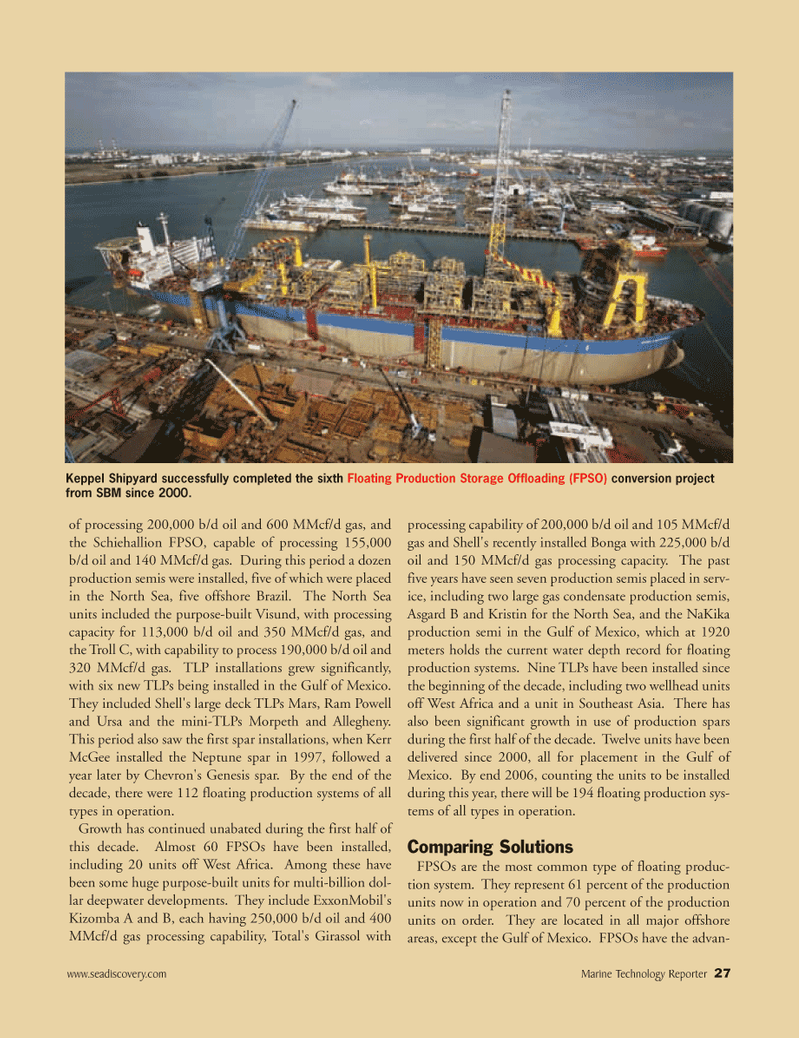
Page 27: of Marine Technology Magazine (April 2006)
The Offshore Technology Edition
Read this page in Pdf, Flash or Html5 edition of April 2006 Marine Technology Magazine
www.seadiscovery.com Marine Technology Reporter 27 of processing 200,000 b/d oil and 600 MMcf/d gas, and the Schiehallion FPSO, capable of processing 155,000 b/d oil and 140 MMcf/d gas. During this period a dozen production semis were installed, five of which were placed in the North Sea, five offshore Brazil. The North Sea units included the purpose-built Visund, with processing capacity for 113,000 b/d oil and 350 MMcf/d gas, and the Troll C, with capability to process 190,000 b/d oil and 320 MMcf/d gas. TLP installations grew significantly, with six new TLPs being installed in the Gulf of Mexico.
They included Shell's large deck TLPs Mars, Ram Powell and Ursa and the mini-TLPs Morpeth and Allegheny.
This period also saw the first spar installations, when Kerr
McGee installed the Neptune spar in 1997, followed a year later by Chevron's Genesis spar. By the end of the decade, there were 112 floating production systems of all types in operation.
Growth has continued unabated during the first half of this decade. Almost 60 FPSOs have been installed, including 20 units off West Africa. Among these have been some huge purpose-built units for multi-billion dol- lar deepwater developments. They include ExxonMobil's
Kizomba A and B, each having 250,000 b/d oil and 400
MMcf/d gas processing capability, Total's Girassol with processing capability of 200,000 b/d oil and 105 MMcf/d gas and Shell's recently installed Bonga with 225,000 b/d oil and 150 MMcf/d gas processing capacity. The past five years have seen seven production semis placed in serv- ice, including two large gas condensate production semis,
Asgard B and Kristin for the North Sea, and the NaKika production semi in the Gulf of Mexico, which at 1920 meters holds the current water depth record for floating production systems. Nine TLPs have been installed since the beginning of the decade, including two wellhead units off West Africa and a unit in Southeast Asia. There has also been significant growth in use of production spars during the first half of the decade. Twelve units have been delivered since 2000, all for placement in the Gulf of
Mexico. By end 2006, counting the units to be installed during this year, there will be 194 floating production sys- tems of all types in operation.
Comparing Solutions
FPSOs are the most common type of floating produc- tion system. They represent 61 percent of the production units now in operation and 70 percent of the production units on order. They are located in all major offshore areas, except the Gulf of Mexico. FPSOs have the advan-
Keppel Shipyard successfully completed the sixth Floating Production Storage Offloading (FPSO) conversion project from SBM since 2000.
MTR#3 (17-32).qxd 4/7/2006 11:30 AM Page 27

 26
26

 28
28
